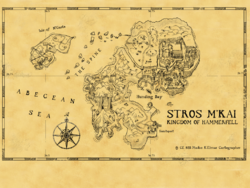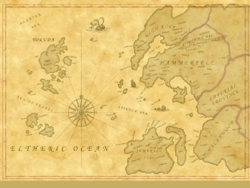General:Hugh Riley's Posts
| Hugh Riley's Posts | |
|---|---|
| Medium/Format | Online Portfolio |
| Interviewee(s) | Hugh Riley |
Contents
- 1 Undated
- 1.1 Portfolio entry on Redguard (Archive)
- 1.2 On the books of Redguard (Archive)
- 1.3 On the maps of Redguard (Archive)
- 1.4 On the model making for Oblivion (Archive)
- 1.5 On the Zombies of Oblivion (Archive)
- 1.6 On the Minotaurs of Oblivion (Archive)
- 1.7 On the Trolls of Oblivion (Archive)
- 1.8 On the Ghosts of Oblivion (Archive)
These are a few notable comments from Hugh Riley on The Elder Scrolls setting.
Undated[edit]
Portfolio entry on Redguard (Archive)[edit]
1998 RedGuard - PC
adventure story and puzzle game, Tomb Raider Style but set deep within the Elder Scrolls history and mythology. I was responsible for very low resoltion (300-500 poly) meshes, textures and animations, plus icons, UI, 2D & 3D inventory objects and all the maps, signs, books and other artifacts found in the game.
On the books of Redguard (Archive)[edit]
The Books played an important part in Redguard. They could be bought or found and contained secrets, riddles and clues to the puzzles throughout the game and helped develop the story and the history of the world. I took great care to keep them and their contents within the developing canon of the Elder Scrolls Universe
On the maps of Redguard (Archive)[edit]
The Maps were important since the Stros M'Kai map, once found in the game, showed your position. It had to be accurate so it was drawn from a render of the world. A copy shipped with the game. The Tamriel map pulled together information from all the existing Elder Scrolls maps and other references. I changed some of the names to give a sense of period change and completely invented the land to the West.
On the model making for Oblivion (Archive)[edit]
Each character artist was responsible for several creatures in Oblivion and was expected to concept each creature and take it through mesh, Uvs and texture/materials, rig it, apply havok, animate, script it into the game and debug it. Any FX on the creature were also our responsibility as were sound triggers, LoDs and weapon hits. I also created several hairstyes and asembled many of the default NPCs and spearheaded the use of ZBrush for normal map creation..
On the Zombies of Oblivion (Archive)[edit]
Zombies were used in many places so for variety I created 2 unique meshes each composed of several bodyparts including split half-torsos, arms, legs, heads and hands.These body parts were interchangeable across the two meshes as they shared vertex positions on the joint lines. Arms and heads had internal caps on neck and shoulders so they could be optional.
I created a variety of walk, run and attack animations and scripted each variant to use one set of these. In this way I was able to assemble several zombie variations and fill a room with a variety of creatures and animations, all sharing one texture and 2 base meshes.
On the Minotaurs of Oblivion (Archive)[edit]
Characters heads were separated from the body to allow expression morphs to be exported with the animation. Addition of skinned geometry to extra bones allowed more animation.
I created an assortment of horns and other attachments which were assembled on differently scaled minotaurs to give creature variety. I assigned an additional texture to a scaled mesh to create a Minotaur Lord. Minotaur used melee plus 2 handed weapons in 1 hand, scaling weapon bone to increase weapon size.
On the Trolls of Oblivion (Archive)[edit]
The Troll's look was derived from the previous Elder Scrolls games as he appears in many of them. I made several alpha'd flats attached at varied angles to give the impression of hair over a relatively low poly character.
His movement was quadrapedal but he fought from a standing position. He was rigged with a jaw so he could roar and bite.
On the Ghosts of Oblivion (Archive)[edit]
The Ghost was built as 2 nested meshes, both with alpha'd textures which became fully transparent towards the lower part, analagous to a semi-transparent torso in a semi-transparent, loosely fitting sheet.A very lo-poly transparent version of the mesh held emitters for the ectoplasmic smoky fx that surrounded it.
The hands and head were animating morph objects, creating an amorphous, constantly-changing floating creature. When this creature died it dropped a havoked morphing blob of ectoplasm which pooled on the floor as the ghost apparently shrank to nothing. In fact the ghost was translated far from the player view but drawn in front of the background so appeared to shrink.

